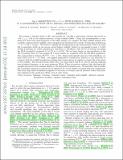| dc.contributor.author | Matejek, Michael Scott | |
| dc.contributor.author | Simcoe, Robert A. | |
| dc.contributor.author | Cooksey, Kathy | |
| dc.contributor.author | Seyffert, Eduardo N. | |
| dc.date.accessioned | 2014-08-06T17:58:54Z | |
| dc.date.available | 2014-08-06T17:58:54Z | |
| dc.date.issued | 2013-01 | |
| dc.date.submitted | 2012-06 | |
| dc.identifier.issn | 0004-637X | |
| dc.identifier.issn | 1538-4357 | |
| dc.identifier.uri | http://hdl.handle.net/1721.1/88550 | |
| dc.description.abstract | We present a detailed study of H I and metals for 110 Mg II absorption systems discovered at 1.98 < z < 5.33 in the infrared spectra of high-redshift QSOs. Using new measurements of rest-frame UV lines from optical spectra of the same targets, we compare the high-redshift sample with carefully constructed low-redshift control samples from the literature to study evolutionary trends from z = 0 → 5.33 (>12 Gyr). We observe a significant strengthening in the characteristic N(H I) for fixed Mg II equivalent width as one moves toward higher redshift. Indeed, at our sample's mean [bar over z] = 3.402, all Mg II systems are either damped Lyα absorbers (DLAs) or sub-DLAs, with 40.7% of systems exceeding the DLA threshold (compared to 16.7% at [bar over z] = 0.927). We set lower limits on the metallicity of the Mg II systems where we can measure H I; these results are consistent with the full DLA population. The classical Mg II systems (W[λ2796 over 0] = 0.3-1.0 A), which preferentially associate with sub-DLAs, are quite metal rich at ~0.1 solar. We applied quantitative classification metrics to our absorbers to compare with low-redshift populations, finding that weak systems are similar to classic Mg II absorbers at low redshift. The strong systems either have very large Mg II and Fe II velocity spreads implying non-virialized dynamics or are more quiescent DLAs. There is tentative evidence that the kinetically complex systems evolve in similar fashion to the global star formation rate. We speculate that if weaker Mg II systems represent accreting gas as suggested by recent studies of galaxy-absorber inclinations, then their high metal abundance suggests re-accretion of recently ejected material rather than first-time infall from the metal-poor intergalactic medium, even at early times. | en_US |
| dc.description.sponsorship | National Science Foundation (U.S.) (Grant AST-0908920) | en_US |
| dc.description.sponsorship | National Science Foundation (U.S.) (Grant AST-1109115) | en_US |
| dc.description.sponsorship | Massachusetts Institute of Technology. Undergraduate Research Opportunities Program | en_US |
| dc.language.iso | en_US | |
| dc.publisher | IOP Publishing | en_US |
| dc.relation.isversionof | http://dx.doi.org/10.1088/0004-637x/764/1/9 | en_US |
| dc.rights | Creative Commons Attribution-Noncommercial-Share Alike | en_US |
| dc.rights.uri | http://creativecommons.org/licenses/by-nc-sa/4.0/ | en_US |
| dc.source | arXiv | en_US |
| dc.title | Mg II ABSORPTION AT 2 < z < 6 WITH MAGELLAN/FIRE. II. A LONGITUDINAL STUDY OF HI, METALS, AND IONIZATION IN GALACTIC HALOS | en_US |
| dc.type | Article | en_US |
| dc.identifier.citation | Matejek, Michael S., Robert A. Simcoe, Kathy L. Cooksey, and Eduardo N. Seyffert. “Mg II ABSORPTION AT 2 < z < 6 WITH MAGELLAN/FIRE. II. A LONGITUDINAL STUDY OF H I, METALS, AND IONIZATION IN GALACTIC HALOS.” The Astrophysical Journal 764, no. 1 (February 10, 2013): 9. | en_US |
| dc.contributor.department | Massachusetts Institute of Technology. Department of Physics | en_US |
| dc.contributor.department | MIT Kavli Institute for Astrophysics and Space Research | en_US |
| dc.contributor.mitauthor | Matejek, Michael Scott | en_US |
| dc.contributor.mitauthor | Simcoe, Robert A. | en_US |
| dc.contributor.mitauthor | Cooksey, Kathy | en_US |
| dc.contributor.mitauthor | Seyffert, Eduardo N. | en_US |
| dc.relation.journal | The Astrophysical Journal | en_US |
| dc.eprint.version | Original manuscript | en_US |
| dc.type.uri | http://purl.org/eprint/type/JournalArticle | en_US |
| eprint.status | http://purl.org/eprint/status/NonPeerReviewed | en_US |
| dspace.orderedauthors | Matejek, Michael S.; Simcoe, Robert A.; Cooksey, Kathy L.; Seyffert, Eduardo N. | en_US |
| dc.identifier.orcid | https://orcid.org/0000-0003-3769-9559 | |
| dspace.mitauthor.error | true | |
| mit.license | OPEN_ACCESS_POLICY | en_US |
| mit.metadata.status | Complete | |
